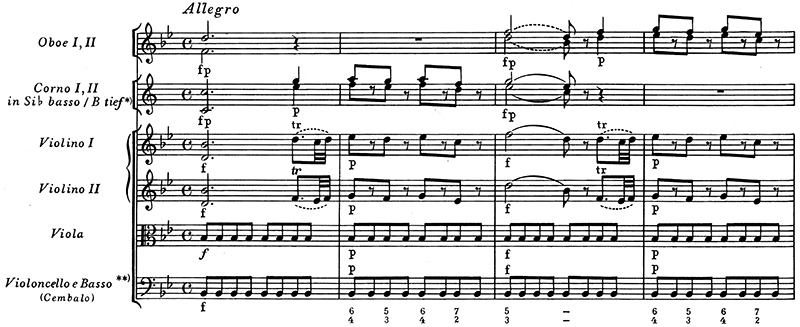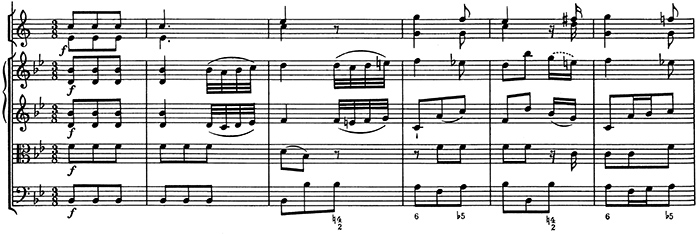Wolfgang Amadeus Mozart
Symphony No.5 in B♭ major, K.22
Media Review / Comparison
2015-02-22 — Original posting
2015-05-02 — Added links to concert reviews
2016-08-03 — Brushed up for better readability
Table of Contents
Introduction / The Recordings
This posting is about the Symphony No.5 in B♭ major, K.22, by Wolfgang Amadeus Mozart (1756 – 1791). I currently have two recordings:
- Christopher Hogwood / The Academy of Ancient Music (1982)
- Jaap ter Linden / Mozart Akademie Amsterdam (2001)
Both these recordings are recent acquisitions on CD. In my LP collection, I only had Karl Böhm‘s complete Mozart symphony recording. I’m not particularly eager to listen to that again…
Background, About the Composition
Wolfgang Amadeus Mozart (1756 – 1791) wrote this symphony in 1765, at the age of 9, around the same time as his preceding Symphony No.4 in D major, K.19 (see there for more comments). This symphony is even shorter: a mere 6 – 7 minutes!
The Movements
The Symphony No.5 in B♭ major, K.22 has three short movements:
I. Allegro (4/4)
98 bars, no repeats
The movement starts with a simple theme with an ostinato accompaniment:
The motoric bass continues for 14 bars and returns after a short, 4-bar interruption. It dominates the entire movement. The young Mozart was of course familiar with popular thematic features. So, he added a “Mannheim crescendo” (a “Mannheim rocket”, as some people call it. Only a part of this section is shown here:
It’s quite an attractive little movement, overall, certainly inspired by music from the Mannheim school.
II. Andante (2/4)
57 bars, no repeats
The slow movement follows more of a baroque pattern (only strings and horn voices shown):
One baroque topos in this movement is the motif of a lamento bass (a bass line descending in half-tones):
III. Molto Allegro (3/8)
97 bars, no repeats
The last movement is the shortest one, a Rondo with 3 ritornelli, 2 intermezzi and a short coda; here’s the beginning of the ritornello (only strings and horn voices shown):
The Interpretations
Both recordings below are historically informed. Both use period instruments:
Christopher Hogwood / The Academy of Ancient Music
Mozart: The Symphonies
Christopher Hogwood / The Academy of Ancient Music
Decca / L’oiseau-lyre 452 496-2 (19 CDs, stereo); ℗ 1979 – 1986 / © 1997
Booklet: 127 pp. e/f/d/i

For general information see the posting “Mozart: Symphony in D, K.19“. Recording date: 1982.
Notes on the Movements
I. Allegro (4/4)
Duration: 2’38”; 1/4 = 160
An excellent interpretation, enthralling, transparent, with bright (maybe somewhat sharp) violin sound, well-balanced.
II. Andante (2/4)
Duration: 2’32”; 1/4 = 46
Hogwood exposes the baroque heritage in this movement. This really sounds like a (late) baroque movement, and in the section around the lamento bass (see above) it could almost be Bach or Handel! I actually think the tempo is too slow for an Andante, but the interpretation features careful articulation, phrasing and dynamics. The reverberation is fairly strong, suggesting that the recording was made in a church.
III. Molto Allegro (3/8)
Duration: 1’29”; 1/8 = 75
Also here, the interpretation sounds closer to late baroque music than with Jaap ter Linden (based on the articulation, sound color and balance, and the prominence of the harpsichord / continuo).
Overall Duration: 6’37”
Rating (see above for details): 4.3 (5 / 4 / 4) — A very good interpretation, overall, a little more baroque than the one below.
Jaap ter Linden / Mozart Akademie Amsterdam
Mozart: Complete Symphonies
Jaap ter Linden / Mozart Akademie Amsterdam
Brilliant classics 94295 (11 CDs, stereo); © 2011
Booklet: 23 pp. English

For general information see the posting “Mozart: Symphony in D, K.19“. Recording date: 2001.
Notes on the Movements
I. Allegro (4/4)
Duration: 2’45”; 1/4 = 150
Jaap ter Linden is a tad slower than Hogwood in this movement, though the difference is hardly noticeable. The sound is full, somewhat darker than Hogwood’s, recorded closer to the orchestra. That’s something I also noticed in the Symphony in D, K.19: one can hear the bow noise in accented bass notes. Overall, the two interpretations are certainly equivalent.
II. Andante (2/4)
Duration: 2’07”; 1/4 = 58
Jaap ter Linden selects a distinctly faster tempo, very appropriate / correct for an Andante. All of a sudden the movement sounds like music from the Mannheim school / Rococo period, and the lamento bass is merely a remote reminiscence from the past. The articulation is somewhat broader than Hogwood’s.
III. Molto Allegro (3/8)
Duration: 1’27”; 1/8 = 78
And again, this sounds like music from the Mannheim school (a contemporary audience might have considered it more modern). The difference is not so much in the tempo, but in the articulation. Here, the focus is on drive, dynamics and expression.
Overall Duration: 6’17”
Rating (see above for details): 5.0 (5 / 5 / 5) — I really like this interpretation — and prefer it over the one with Christopher Hogwood.
Addendum
Mozart’s Symphony in B♭, K.22 is featured in a concert at the Tonhalle in Zurich, on 2015-03-28, with Sir Roger Norrington and the Zurich Chamber Orchestra. See my concert review for Bachtrack.com. As this is in German, I have written up a separate, more extended review in the posting “Norrington & Arabella Steinbacher in Zurich, 2015-03-28“.











